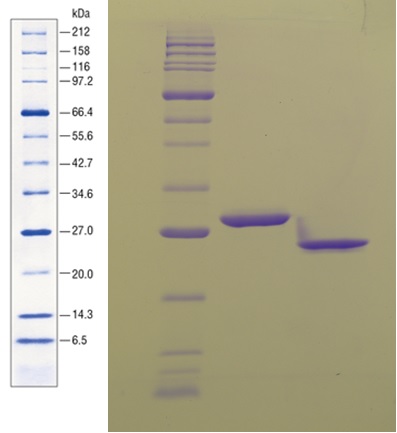
- Name: PD-L1
- Synonyms: Programmed cell death 1 ligand 1, PDCD1 ligand 1
- Catalogue Number:PT-OP-0001
- Application:Research in immunotherapy
- Price: $ 120 100ug $ 500 500ug $ 900 1mg
- Number:
- Concentration:0.5mg/ml
- Store:Avoid repeated freeze-thaw cycles. 12 months at -20 C to -80 C. 1 month at 2 C to 8 C.
Description: Recombinant human PD-L1/CD274, extracellular domain is produced in E. coli. The final protein sequence contains F19-H240 of human PD-L1 fused to a polyhistidine tag on the carboxyl terminus.
Background: PD-L1 is a ligand for program cell death 1 (PD1). PD-L1 suppresses immune response against tumor cells upon binding to PD1 receptor. PD-L1 is expressed on T and B cells, macrophages, dendritic cells, and some nonimmune cells. Binding of PD-L1 to its receptor, PD1 on the surface of T cells resultes in deactivation of T cells. Blockade of PD-1 or PD-L1 by specific antibodies leads to enhanced antitumor immunity of T cells.
Sequence :MPGFTVTVPK DLYVVEYGSN MTIECKFPVE KQLDLAALIV YWEMEDKNII QFVHGEEDLK VQHSSYRQRA RLLKDQLSLG NAALQITDVK LQDAGVYRCM ISYGGADYKR ITVKVNAPYN KINQRILVVD PVTSEHELTC QAEGYPKAEV IWTSSDHQVL SGKTTTTNSK REEKLFNVTS TLRINTTTNE IFYCTFRRLD PEENHTAELV IPELPLAHPP NERTHHHHHH
Accession #: Q9NZQ7
Quality control: Verified by disulfide mapping and Mass Spectrometry analyses.
Product Source: PD-L1 was produced in E. coli cells transformed with the coding sequence of the extracellular domain of human PD-L1 gene.
Usage: FOR LABORATORY RESEARCH USE ONLY.
References:
Hamanishi, Junzo, et al. "Programmed cell death 1 ligand 1 and tumor-infiltrating CD8+ T lymphocytes are prognostic factors of human ovarian cancer." Proceedings of the National Academy of Sciences 104.9 (2007): 3360-3365.
Lin, David Yin-wei, et al. "The PD-1/PD-L1 complex resembles the antigen-binding Fv domains of antibodies and T cell receptors." Proceedings of the National Academy of Sciences 105.8 (2008): 3011-3016.
| Cat No.: | PT-OP-0001 |
| Product Name: | PD-L1 |
| Type: | Protein |
| Property: | |
| Origin: | |
| Source: | E.coli |
| Application: | Research in immunotherapy |
| Formulation: | Sterile filtered through a 0.2 micron filter in 20 mM Tris buffer at pH8. |
| Purity: | >95% by SDS-PAGE gel |
| Storage: | Avoid repeated freeze-thaw cycles. 12 months at -20 C to -80 C. 1 month at 2 C to 8 C. |
| Limitation: | |
| Note: |